#Software Patterns
Explore tagged Tumblr posts
Text
Efficient Web Application Management with Modular Designs
When designing with modularity in web application development the sole main focus is enhancing efficiency, scalability, and maintainability . This actually possible by breaking down an application into independent, reusable modules. In contrast to a monolithic approach, where all components are tightly coupled, modular architectural design structures the application into separate, self-contained units. In such case, you can modularize the account verification, product management, and payment processing.
This separation allows web developers to work on individual modules without disrupting the entire system, making updates, debugging, and feature additions more manageable. Just like by following Laravel’s modular principles using Service Providers, Repositories, and Packages, teams can develop cleaner, more structured codebases that are easier to scale and maintain.
Support Parallel Development and Flexibility
Modular architecture enables software development teams to build, test, and deploy individual features independently. If one module requires changes or optimizations, it can be modified without affecting the rest of the application, reducing downtime and improving development speed. So, the modular architecture is particularly beneficial for large-scale applications like an office furniture online system, where different teams may handle inventory, customer management, and order processing as separate modules. Try implementing modularization with Laravel, you'll achieve a robust, high-performing, and future-proof web application that efficiently adapts to growing demands.
#modular#architecture#modular architecture#laravel modular architecture#modular design#office furniture#online office furniture system#high performance#laravel modules#laravel framework#PHP framework#web application design#monolithic#parallel development#large scale applications#service providers#flexibility#maintainable application design#scalable application design#coupling#cohesion#reusable patterns#software patterns#software testing#web deevlopment
0 notes
Photo

Service Oriented Architecture (SOA) Design Principle: Coupling, Cohesion, and Granularity
This is a short preview of the article: In the realm of Service Oriented Architecture (SOA) design principles, the concepts of Service Coupling, Service Cohesion, and Service Granularity play pivotal roles in shaping a robust and effective architectural framework. Service Coupling refers to the degree of interdependence between any two
If you like it consider checking out the full version of the post at: Service Oriented Architecture (SOA) Design Principle: Coupling, Cohesion, and Granularity
If you are looking for ideas for tweet or re-blog this post you may want to consider the following hashtags:
Hashtags: #API, #APIs, #Cohesion, #ComputerScience, #Coupling, #DesignPatterns, #Granularity, #ServiceOrientedArchitecture, #SOA, #SoftwareArchitecture, #SoftwareEngineering, #SoftwarePatterns
The Hashtags of the Categories are: #Java, #Programming, #Python, #SoftwareEngineering
Service Oriented Architecture (SOA) Design Principle: Coupling, Cohesion, and Granularity is available at the following link: https://francescolelli.info/software-engineering/service-oriented-architecture-soa-design-principle-coupling-cohesion-and-granularity/ You will find more information, stories, examples, data, opinions and scientific papers as part of a collection of articles about Information Management, Computer Science, Economics, Finance and More.
The title of the full article is: Service Oriented Architecture (SOA) Design Principle: Coupling, Cohesion, and Granularity
It belong to the following categories: Java, Programming, Python, Software Engineering
The most relevant keywords are: API, APIs, Cohesion, computer science, Coupling, Design Patterns, Granularity, Service Oriented Architecture, SOA, software architecture, software engineering, Software Patterns
It has been published by Francesco Lelli at Francesco Lelli a blog about Information Management, Computer Science, Finance, Economics and nearby ideas and opinions
In the realm of Service Oriented Architecture (SOA) design principles, the concepts of Service Coupling, Service Cohesion, and Service Granularity play pivotal roles in shaping a robust and effective architectural framework. Service Coupling refers to the degree of interdependence between any two
Hope you will find it interesting and that it will help you in your journey
In the realm of Service Oriented Architecture (SOA) design principles, the concepts of Service Coupling, Service Cohesion, and Service Granularity play pivotal roles in shaping a robust and effective architectural framework. Service Coupling refers to the degree of interdependence between any two business processes. In the context of SOA, weak coupling is highly preferred as…
#API#APIs#Cohesion#computer science#Coupling#Design Patterns#Granularity#Service Oriented Architecture#SOA#software architecture#software engineering#Software Patterns
0 notes
Text
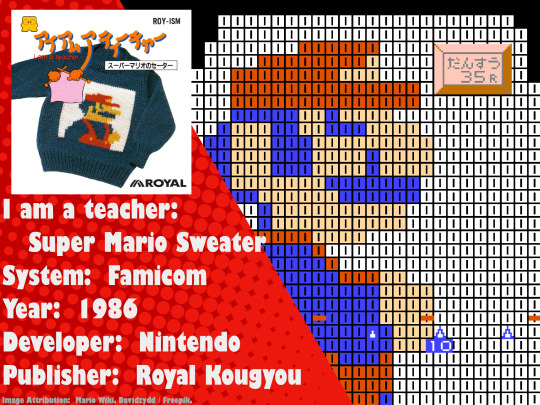
#mario poll#nintendo#super mario#is it a mainline super mario game#mainline super mario game poll#mainline super mario poll#what is a mainline super mario game#super mario sweater#for those of you asking yes this is literally just a program that gives you knitting patterns for mario characters#this is a real piece of software#i'm covering as many bases as I possibly can here
219 notes
·
View notes
Text
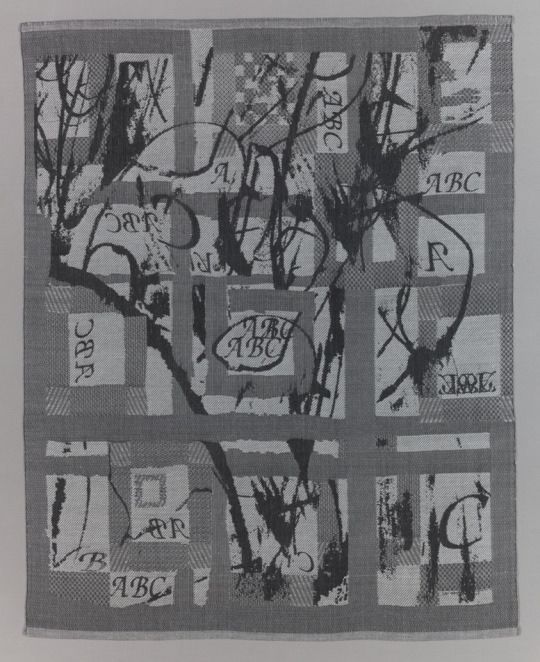
Cynthia Schira, Panel Entitled "ABC Drawn Quilt", (cotton and linen, areas of warp-float faced 7:1 satin weave; warp and weft-float faced 7:1 twill weaves; diamond and point twills; combined twill; and plain weaves with areas of paired warps or wefts and plain weaves self-patterned by main warp and ground weft floats; woven on TIS Jacquard handloom with Jacquard Computer Aided Design), 1998 [The Art Institute of Chicago, Chicago, IL. © Cynthia Schira]

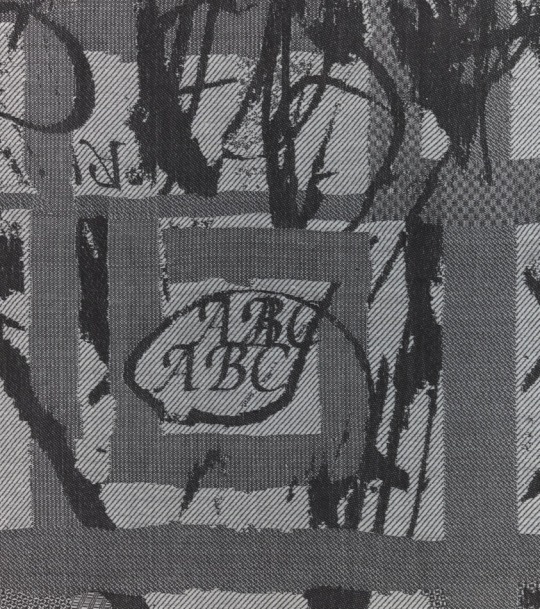
#art#textile#quilt#computer technology#computer art#mixed media#visual writing#geometry#pattern#cynthia schira#jacquard computer aided design#jacquard design software#the art institute of chicago#1990s
22 notes
·
View notes
Text

potd 35: girls night ‼‼
#really proud of this ally btw. ignoring her hue I think I got their patterns dow really well#at least about as well as you can do in a software with no layers (I refuse to download the new version of ms paint#media chatter#phtr6g#bhop art
88 notes
·
View notes
Text
Coding tutorial: Chain-of-responsibility pattern
A peasant, knight and king walk into a software design tutorial, and are here to teach you the chain-of-responsibility pattern. Learn how to create a chain of handlers which can handle different request types.
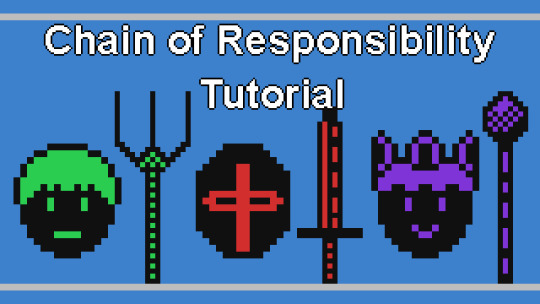
This tutorial shows you how to code the chain-of-responsibility pattern in the Visual Studio development environment, using a console application and the C++ programming language.
The chain-of-responsibility pattern passes on a request to a chain of handlers one at a time. Each handler can handle different requests. So if the first handler can’t handle the request, then it will pass it on to the next handler. Once a request is handled, the chain ends. Since there is no longer a need to pass on the request.
It is also possible that the request doesn’t get handled by any of the handlers. Since each handler can handle 0, 1 or many requests of different types.
See the full tutorial here.
Console output:

#cpp#coding#programming#gamedev#indiedev#tutorial#visual studio#software#software design#software development#game development#design patterns#cppprogramming
20 notes
·
View notes
Note
How do you design your patterns for knitting?? They are so pretty! 😍
In Excel (or the spreadsheet program of your choice*). First I set the ratio of the cells so each cell is one stitch. Double knitting, like for the blanket is a 2:3 ratio, roughly, which means that every two stitches across is about the same length as three stitches upwards. So I set the width of each column to 0.3 cm and the height of each cell to 0.2 cm. (For contrast, standard colourwork is usually closer to a 4:5 ratio, so don't use double knitting diagrams for single knitting or vice versa)
(Weirdly, in Excel you only seem to be able to adjust in centimetres if you put the spreadsheet in print view first, so it looks like different pages, idk why. Excel sucks like that I guess.)
*Not Google Sheets, because last time I checked it doesn't allow background images. This may have changed since.
Then I put a thick black border around the limits of my pattern. For the baby blankets it's about 176 columns by 264 rows, though the width is subject to change a little based on the pattern (if I decide on a repeating border it has to be divisible by the right number), and if I change that, I might adjust the length as well because I want the blankets to be roughly square.
Once that's done, I decide on a theme and a rough idea of what I want it to look like. For my most recent blanket I knew I wanted mountains because my friends like to hike. I knew I wanted space because one of them is really into space stuff. And I knew I wanted chickens because the other has chickens that she loves.
When I know roughly what elements I want to include, I do an image search for silhouettes of that thing. This is one of the reasons I haven't made any of the patterns available, because copyright. I do transform the images I find, and some of the elements (borders, patterns) are entirely from my own mind, but there's a lot that's based off images I find. I don't specifically go searching for creative commons images because it's personal use and the only place I even show pictures of them is here on Tumblr. Like I said, I transform them, and it's personal use, so I'm pretty sure I'm clear just making my blankets for my friends, but any further might be questionable. Idk. Copyright is a thorny sort of a thing.
ANYWAY. I get a silhouette image (silhouettes because they're clearer, although one of the chickens on the latest blanket is from a photograph, but that's trickier to work with). Then I set it as the background of my Excel spreadsheet.
One interesting thing about Excel is that the zooming in and out doesn't affect the background image like it does the cells, so I zoom in or out until the image is about the size I want in relation to the size of the whole blanket. Then I colour in the cells on top of it. At first it's just the cells that are completely filled in in the image below, then it's the ones that are half filled in or more.
Once that's done, I remove the background image and I fuck around with what's left (essentially a pixel art version of the silhouette). This is the stage that takes a lot of time, because there's often a lot of tweaking to do to make it look good. Fine lines and curves are difficult, and sometimes things just need to be changed. For instance, the owl on my most recent blanket started out life as a long-eared owl and I changed it into a barn owl because that suited my aesthetic more. The mouse I adjusted the size of multiple times and the shape of the back and the ears and the nose... and the tail... to make it fit the space I wanted it in and also to make it look more mouse-like. Literally changing one cell can make a huge difference to how something looks, it's crazy.
For borders and decorative bits, I tend to just mess around with colouring in the cells in swirly patterns until I come up with a shape I like. Repeating patterns are a lot easier to do, but do require you to do maths to make sure they fit properly. This probably requires patience, but I find it strangely addictive and zen-like.
For the ivy on my last one, I used silhouettes for the leaves, then used the transform tools in excel to mirror the five or six different leaf silhouettes I had vertically and horizontally, then moved them around and connected them with twisting lines to create the impression of vines.
Once I've got all the separate pieces, I copy them all into the outline I have of the blanket and move them around (it's important to keep the originals separate, because when you move things in excel you can often copy over something and chop off an ear or a tail or half a bird).
But yeah, then I move stuff around until the layout works for me. Sometimes at this point I have to resize things, which is annoying.
Then, when I've got things roughly in place, I mess around with them some more until they look right. It's a lot of trial and error at this stage
For example, in the dragon and unicorn blanket I did, the dragon's tail was messed around with a lot at this point. I had it curling one way, then the other way. I made it really long. I made it really short. I had it end with spikes. I had it end with the spade.
As a final touch, I then add the more random details that don't need as much work, like the stars or the snowflakes, which are fairly easy to just design on the spot. I move those around as well, until I'm happy with them.
Then I start knitting.
The design does often evolve as I'm knitting. For instance, after seeing how the tension worked on the mouse in my most recent blanket, I realised that the planet was going to be stretched thin the way I had initially designed it, so I tweaked it to be fatter so it would appear more round in the finished product. Similarly I added some more leaves to the tree and moved the top branch down a bit for better framing.
That got kind of long, but I hope it helps.
#Ask me stuff#Knitting#stitchcraft#how I create knitting patterns#Anonymous#Making patterns for colour or cabling when there are increasing or decreasing rows is a lot more difficult#because you need to take into account where the decreases are and the changing number of stitches per row#But I have done that as well#One day I will finish my Rivendell Cable poncho#One day#I know Microsoft didn't intend to create a knitting pattern software#but they did#Also worth noting#Don't try and open a design from Excel in Google Sheets#it will not work#the column widths will fuck up#Luckily when you download it and open it in Excel or LibreOffice it looks fine still#but Google Sheets hates me
13 notes
·
View notes
Text
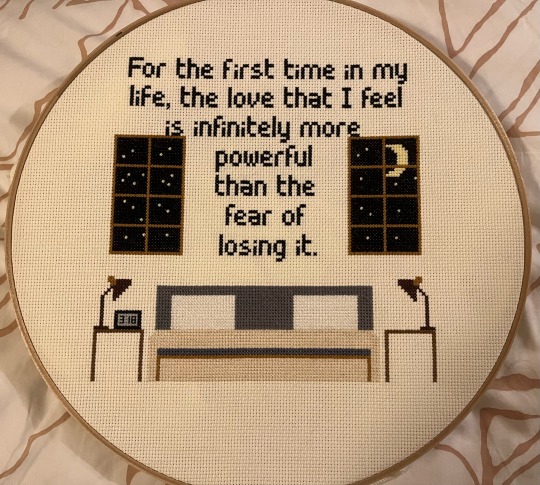
It’s love ❤️
#i bought some cross stitch pattern making software and this is my first attempt attempt at using it to create my own pattern#I’m pretty happy with how it turned out!#at least a somewhat fitting tribute to my favorite scene of all time#lone star cross stitch#911 lone star#Episode: s03e18 a bright and cloudless morning
244 notes
·
View notes
Text
Leliana is voiced by an actual French actress, and is just speaking: wow this sounds so fake
Characters have actual real proportions, instead of hero proportions: wow this looks so weird
Characters converse like people with facets, instead of archetypes: wow this sounds so bad
Writers interact like actual human beings who make art and are inspired by feedback: wow this is so unprofessional
#Dragon age#Veilguard#Da fandom critical#Do you hate human beings#God forbid we move away from the lower tier qualities that makes people able to call REAL HUMAN BEINGS “npcs”#Art is a passion until you start doing it “incorrectly”#Then you get lumped in with all the shitty “devs” 😤#I'm not *not* guilty of some of these#But instead of doubling down#You can accept that the pattern recognition software in your brain only noticed that the pattern was interrupted#Perhaps that pattern was flawed and this is better now - actually
9 notes
·
View notes
Text

[ID: three cross stitch cat paws. The leftmost is pink and white with black outlines, the center is brown and orange with black outlines, and the rightmost is gray and black with white outlines. End ID]
Ignore that it took me almost a week to complete the set, but I did it!
DMC threads used: (BLANC, 603, 310), (741, 434, 310), (310, 535, BLANC)
Chart I made is below the cut, have fun and make your own if you want!
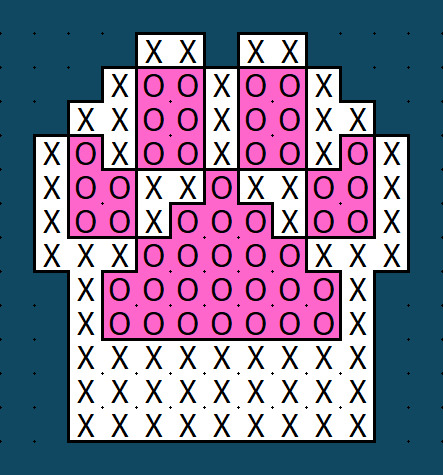
[ID: a cross stitch chart of a white and pink cat paw. End ID]
#boop#boop!#cross stitch#cross stich pattern#free cross stitch pattern#one day ill actually get cross stitch software#until then its me and excel against the world#ecdysing#moss’s crafts
45 notes
·
View notes
Note
40 for the ask game
40. what’s the most interesting item you own?
hmmmmmmmm……
Ooh! Not sure if this is a good answer, but in college when I bought the cheapest used copy of the famous Go4 Design Patterns textbook I could find, I was surprised to find that it had been signed by 3 of the 4 authors!

just needs Erich Gamma to complete the set!
full list for those who want to play
3 notes
·
View notes
Photo

What Software Patterns (or Design Patterns) are and an introduction to the most common one
This is a short preview of the article: Software patterns, often referred to as design patterns, are a reusable and generalizable solution to a common problem that software developers face when designing and building software applications. Design patterns are essentially templates or blueprints for solving recurring design problems in
If you like it consider checking out the full version of the post at: What Software Patterns (or Design Patterns) are and an introduction to the most common one
If you are looking for ideas for tweet or re-blog this post you may want to consider the following hashtags:
Hashtags: #Adapter, #ClassDiagram, #ComputerScience, #DesignPatterns, #Facade, #Observer, #Proxy, #SoftwareArchitecture, #SoftwareEngineering, #SoftwarePatterns, #UML, #UMLDiagram
The Hashtags of the Categories are: #Java, #Programming, #Python, #SoftwareEngineering
What Software Patterns (or Design Patterns) are and an introduction to the most common one is available at the following link: https://francescolelli.info/software-engineering/what-software-patterns-or-design-patterns-are-and-an-introduction-to-the-most-common-one/ You will find more information, stories, examples, data, opinions and scientific papers as part of a collection of articles about Information Management, Computer Science, Economics, Finance and More.
The title of the full article is: What Software Patterns (or Design Patterns) are and an introduction to the most common one
It belong to the following categories: Java, Programming, Python, Software Engineering
The most relevant keywords are: adapter, Class diagram, computer science, Design Patterns, facade, observer, Proxy, software architecture, software engineering, Software Patterns, UML, UML diagram
It has been published by Francesco Lelli at Francesco Lelli a blog about Information Management, Computer Science, Finance, Economics and nearby ideas and opinions
Software patterns, often referred to as design patterns, are a reusable and generalizable solution to a common problem that software developers face when designing and building software applications. Design patterns are essentially templates or blueprints for solving recurring design problems in
Hope you will find it interesting and that it will help you in your journey
Software patterns, often referred to as design patterns, are a reusable and generalizable solution to a common problem that software developers face when designing and building software applications. Design patterns are essentially templates or blueprints for solving recurring design problems in a systematic and efficient way. Design patterns serve several important purposes in software development:…
#adapter#Class diagram#computer science#Design Patterns#facade#observer#Proxy#software architecture#software engineering#Software Patterns#UML#UML diagram
1 note
·
View note
Text
I’m trying to create a knitting pattern for a thing because I can’t find one that is exactly what I want and the math is killing me. I can visualise exactly what I want it to look like but the math for the pattern is ???? I’ve lost count of how many times I’ve miscalculated the increases I need
#can’t I just wing it#I’ve done it before#thought tbf that time it was just an asymmetric triangle shawl with a lace edge#so easy to wing#but this is going to be a bit more complicated and I’m 😐#I even tried looking up knitting pattern softwares and creators online but they were like arcane magic#I feel like I need graph paper that is true to scale so I can just draw on it#can one get graph paper true to scale?? like graph paper bigger than my body??#what if i just cast on and yolo#knitting
7 notes
·
View notes
Text
Spend the whole day revising the pattern. Am a lot happier with it now, especially the eye.
Old version:
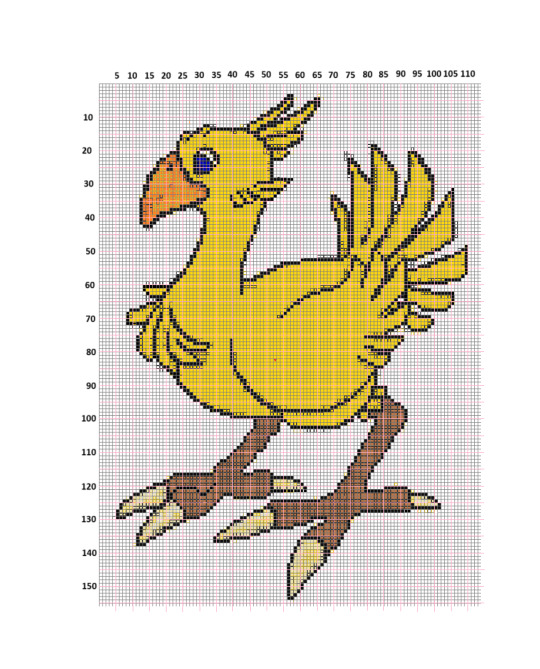
New version:
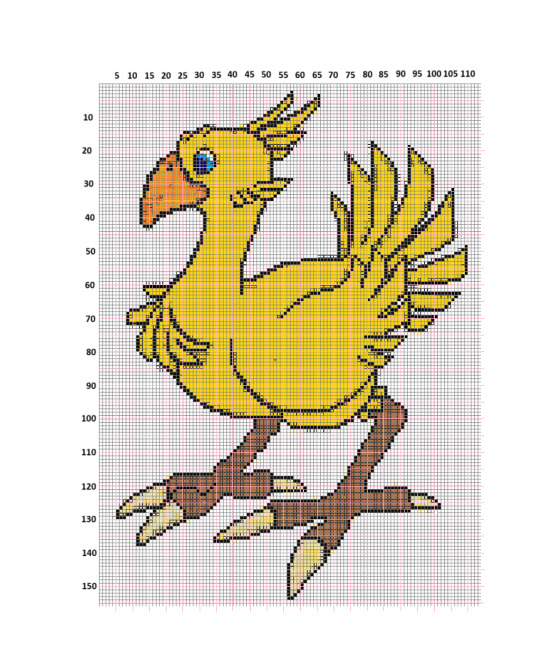
#sadly this means i dont have a paper pattern until i can print again on friday#which i shall do sneakily because damn am i using my dad's yellow ink with this one#also this is still an ms paint mess because yeah no#next project i will look into decent pattern software#some spaces are ugly because when i changed colour the edges stayed the old one and i cannot be assed to clean it up
3 notes
·
View notes
Note
For the vintage outfit meme could i ask for Tango A4 or Grian B7 perhaps even Xornoth B4? :D


Xornoth :D
Ask Game!!!
#sorry it took so long -_-"#my drawing software broke when i was testing out the flower pattern and it got stuck that way lol#xornoth#empires smp#empires smp s1#xornoth fanart#empires smp fanart#mcyt#tbh he is one of my favourite guys to draw.#will 100% work on the tango one and the grian one intrigues me!!!#my art
36 notes
·
View notes
Text
Coding tutorial: Observer pattern
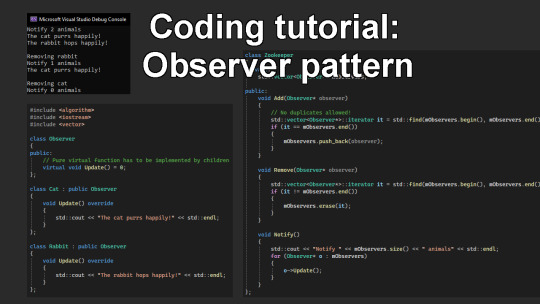
The observer pattern has an object named the ‘subject’ which maintains a list of ‘observers’. The subject will notify all the observers when an event occurs. The observers can then choose how they wish to respond to the event.
In this tutorial you will code a zookeeper and animals. The zookeeper represents the subject of the observer pattern. Whilst the animals represent the observers.
The zookeeper will notify the animals when he arrives, and the animals will respond in there own unique way.
To follow along to this tutorial, you can either just read it and apply the knowledge to your programming language. Or you can use Visual Studio, by creating a solution, then create a project with a console application. Then run the project to see the output in the console window.
Walkthrough and full code example on the blog:
#cpp#programming#coding#gamedev#indiedev#visual studio#tutorial#software#software design#software development#design patterns
24 notes
·
View notes